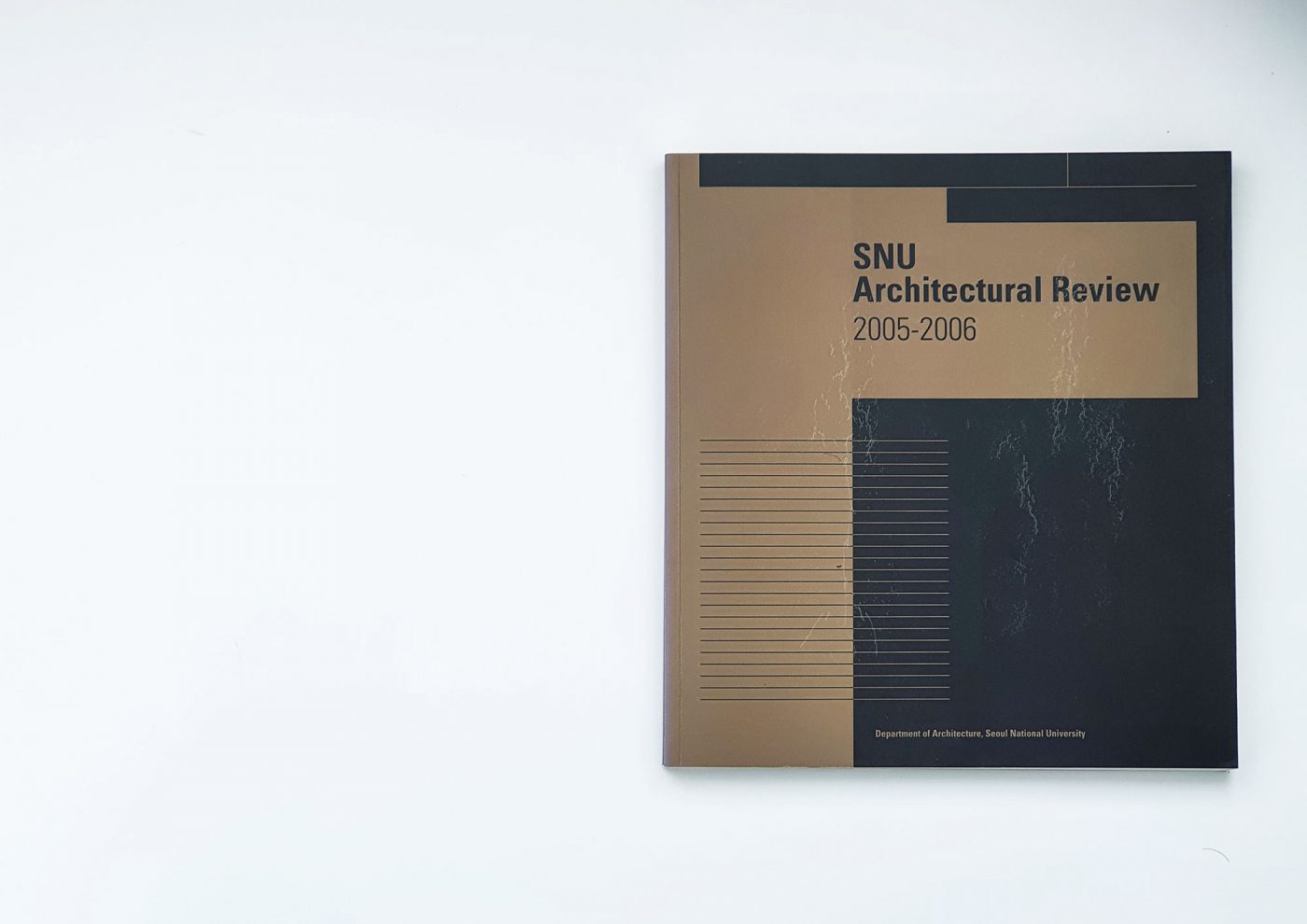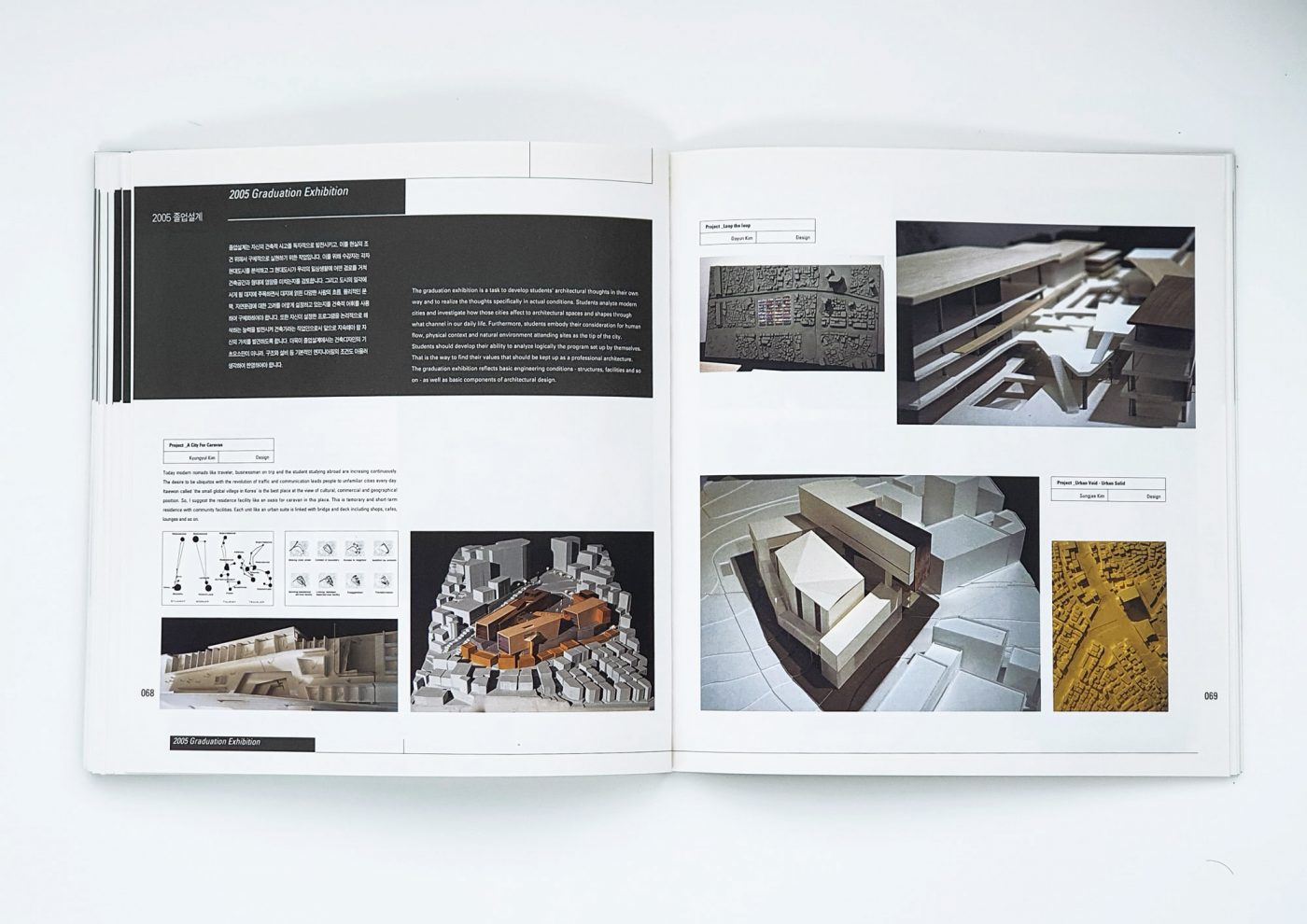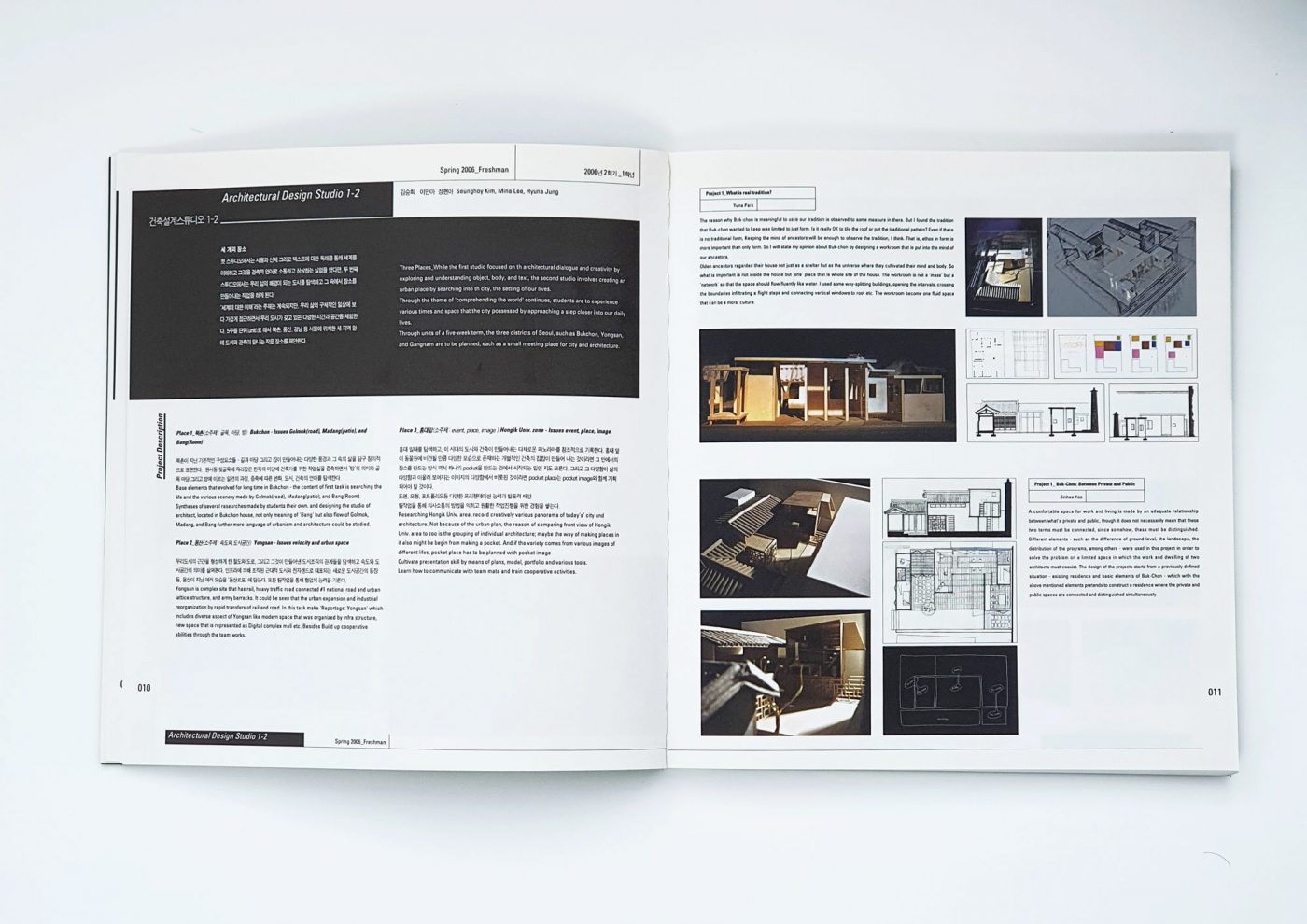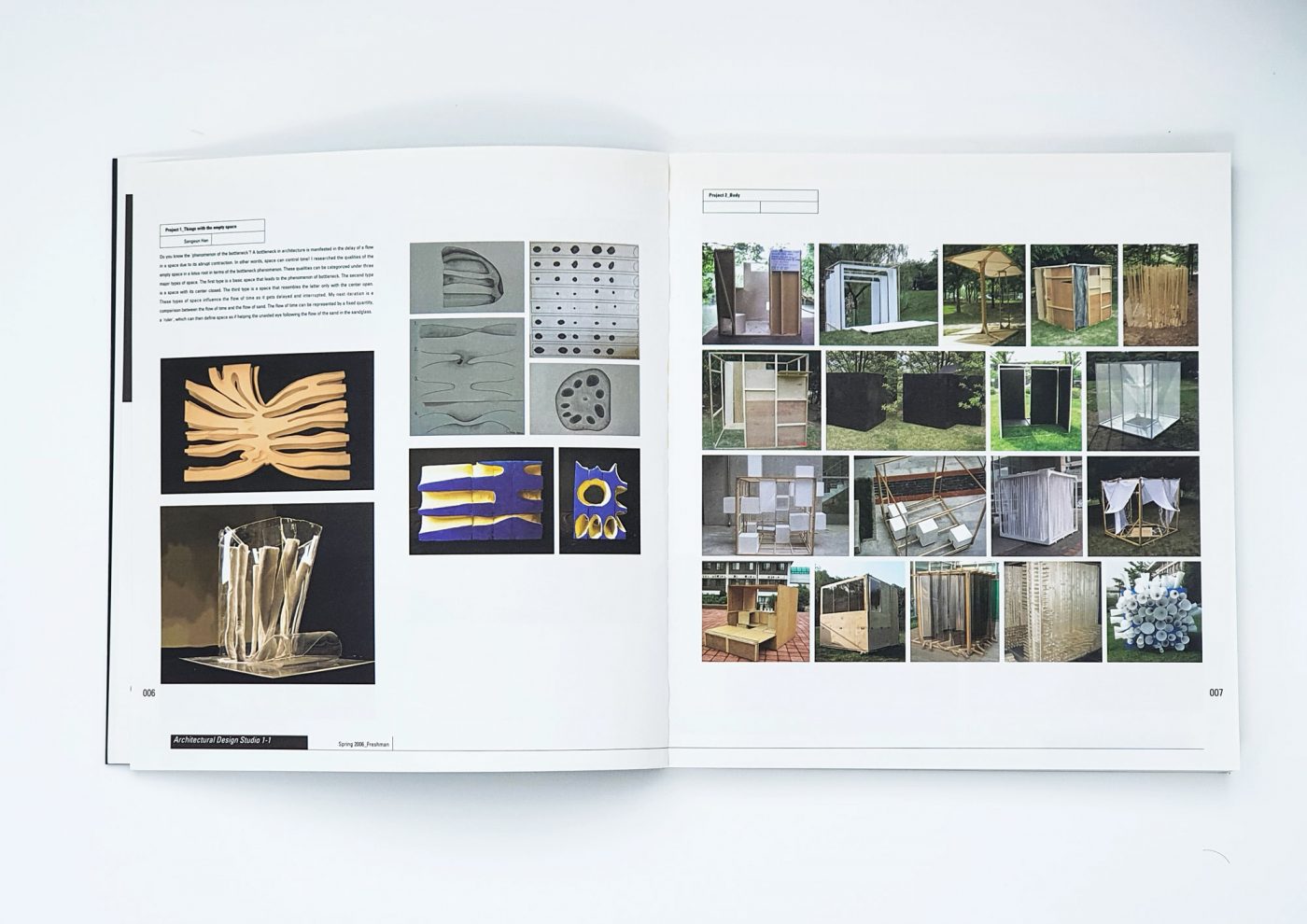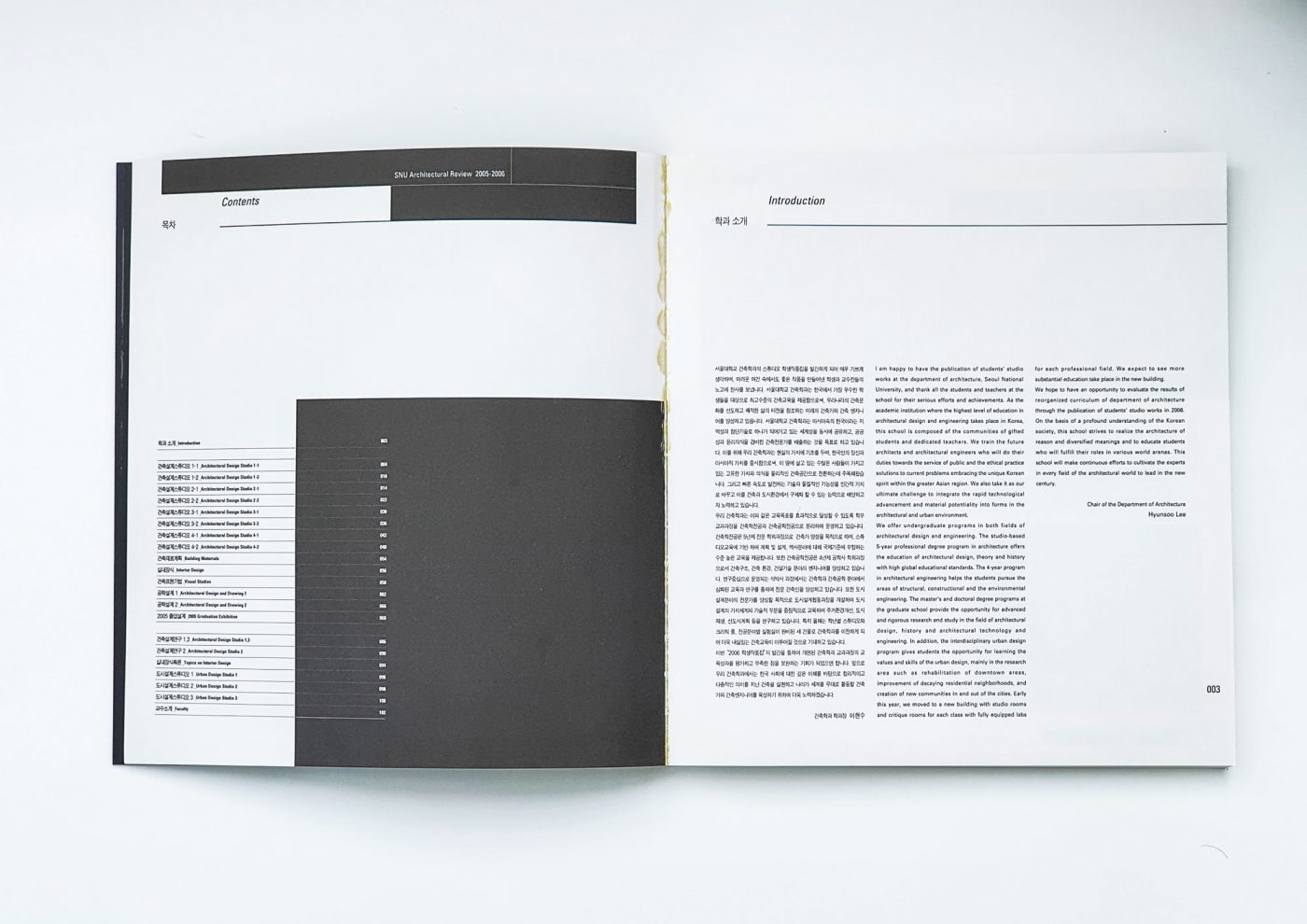SNU Architectural Review
2005 – 2006
2006, 1-1
건축설계스튜디오 1-1
신체, 사물,텍스트
김승회, 이민아, 정현아
양명석, 신세철, 한승은, 이규빈, 이준희, 이주현
1학년 설계스튜디오는 '세계에 대한 이해'에 초점이 맞추어져 있다. '신체' 와 '사물', '텍스트들' 이라는 세가지의 주제의 탐구를 통해 관찰과 분석 그리고 그것을 해석하는 능력을 키운다. 세가지의 주제는 비건축적인 주제이지만 건축의 배경이 되는 요소이자 세계에 대한 이해의 기반이다. 각각의 주제에 대한 독창적인 관찰과 창의적인 해석을 구체적인 도면과 모형을 통해 표현하는 방법을 익힌다.
The theme of this studio iws 'how to read the surronding and world'. Throught the researching on the 3 kinds of texts; things and place, we are developing abilitiies of observation, analysis and interpretation. Even though these 3 texts are not architectural themes, these are the background of architecture and the foundation of understanding the world. We are also learning how to express result of observation and unique analysis as a specific plan and model.
2006, 1-2
건축설계스튜디오 1-2
세 개의 장소
김승회, 이민아, 정현아
박유나, 유진희, 최종빈
세 개의 장소: 첫 스튜디오에서는 사물과 신체 그리고 텍스트에 대한 독해를 통해 세계를 이해하고 그것을 건축적 언어로 소통하고 상상하는 실험을 했다면, 두번째 스튜디오에서는 우리 삶의 배경이 되는 도시를 탐색하고 그 속에서 장소를 만들어내는 작업을 하게 된다. '세계에 대한 이해'라는 주제는 계속되지만, 우리 삶의 구체적인 일상에 보다 더 가깝게 접근하면서 우리 도시가 갖고 있는 다양한 시간과 공간을 체험한다. 5주를 단위(unit)로 해서 북촌, 용산, 강남 등 서울에 위치한 세 지역 안에 도시와 건축이 만나는 작은 장소를 제안한다.
Three Places_While the first studio focused on the architectural dialogue and creativity by exploring and understanding object, body, and text, the second studio involves creating and urban place by searching into the city, the setting of our lives. Through the theme of 'comprehending the world' continues, students are to experience various times and space that the city possessed by approaching a step closer into our daily lives. Through units of five-week term, the three districts of Seoul, such as Bukchon, Yongsan, and Gangnam are to be planned, each as a small meeting place for city and architecture.
2006, 2-1
건축설계스튜디오 2-1
디자인 어떻게 할 것인가?
최두남, 임재용, 존 피어볼린
김준홍, 전홍철, 김덕환, 최종빈, 허전수, 문승규, 이보름, 허규영, 정유리, 양시영, 유진희, 조홍재
이 과목은 공간을 설계함에 있어 주어진 환경 및 대지를 면밀히 관찰, 분석하고 공간구성의 틀을 만드는 기본적인 건축개념들의 학습을 통하여 사용자의 기능에 대한 요구를 만족시키며 개념이 내재된 조형을 이용하여 건출을 구축하는 방법을 습득하는 것을 목표로 한다. 건물을 포함한 전체 대지를 설계함으로써 대지분석에 대한 중요성을 강조하고 설계 진행과정에서 설계의도를 효율적으로 표현할 수 있는 설득력과 시각적 표현기법의 숙달을 꾀하며 자료 분석을 통한 사용자, 기능 및 프로그램에 대한 철저한 이해가 이루어질 수 있도록 한다.
The objective of this course is to help students to learn the process of design by encouraging them to get familiarized with the basic architectural concepts. Students are asked to carefully analyze the given context and the site, which are important part of design considerations, in the process of establishing architectural concepts that would reflect architect's aesthetic vision. Emphasis will be given on having students engaged in total design process in which students would learn to address such issues as site planning, program analysis and building design.
2005, 2-2
건축설계스튜디오 2-2
재료와 물성
최두남, 권문성, 임재용
박종현, 조준희, 박도현, 류충석, 박민환, 안병식, 이강현, 기세호, 김형주, 서희원, 박대준, 정윤해
이 과목은 설계를 진행함에 있어 공간 창출과 완성에 필요한 기술적인 측면에 대한 비중 있는 탐구를 통하여 재료에 대한 이해와 물성에 대한 감각을 높이며 건물이 구축되어지는 시공과정과 건물 구조 시스템에 대한 포괄적인 이해와 탐구가 이루어지도록 한다. 적절한 재료선택에 필요한 기본적인 건축적, 기술적인 지식을 바탕으로 다양한 구조시스템의 가능성 및 잠재성에 대한 개괄적인 이해가 이루어질 수 있도록 한다.
The objective of this course is to emphasize the importance of the technical aspect of architectural design by having students pay attention to building materials and structural systems. Students will have opportunities not only to examine the potential design possibilities of various structural systems but also to develop tectonic awareness of building materials.
2005, 3-1
건축설계스튜디오 3-1
관계 짓기
김현철, 오동희, 이영범
서희원, 안병식, 조준희, 김원영, 박도현, 박진석, 기세호, 윤희영
3학년 설계스튜디오는 단순 사용자 건물 혹은 단일개체 설계에서 다중 사용자/ 다중개체 설계를 나아감을 목표로 한다. 이를 위하여는 구조는 단일 완결 구조에서 반복구조로, 중규모의 다양한 사용자가 이용하는 기능을 다룬다. 이 과정에서는 다양한 건물관 관계 짓기/건물군과 도시 컨텍스트 사이 관계짓기로 이루어지는 배치계획과 특정한 형태를 고안하는 형태계획이 중점적으로 다루어진다. 기능상으로는 특수한 건축물이 갖추어야 할 프로그램에 대해 숙지할 기회를 제공한다. 이를 위하여 3개의 스튜디오에서는 서로 다른 3개의 프로그램을 상이한 대지조건에 설계하도록 하여 학생들에게 다양한 프로그램을 선택할 수 있는 기회를 제공한다.
Architectural design studio 3-1 has the goal of processing from a simple building for individual user to a complex building for various users. In the assignment, site planning and shape planning will be the main work derived from making relationship among different buildings, building complex and the urban context. Students will have the opportunity for understanding program of specialized buildings. For this, students can select their own program from 3 different projects in 2 groups.
2005, 3-2
건축설계스튜디오 3-2
어떻게 통제할 것인가
김현철, 오동희, 이형욱
권도엽, 마승범, 이재근, 임지환, 강건영, 문주호, 김동욱, 이새롬, 임강륜
건축설계스튜디오3-1에 이어서 공간과 기능을 동시에 제어하는 연습을 하는 스튜디오이다. 다중 사용자 건물이면서 일시 대량사용이 되는 공연장 건물이 기술적, 공간적으로 필요로 하는 지식을 습득하고 단계별로 공간설계를 진행한다. 특히 반복적인 기능적 실들의 평면과 구조, 모듈, 공간표현을 추가 연습하며, 건축설계스튜디오3-1에서 수행한 공간 연습 기본사항을 숙지하고, 도시적 컨텍스트가 도시꼴을 통해 어떻게 반영되는지 고려하는 연습을 심화된 형태로 반영하도록 한다.
This studio is for practicing how to control space and function followed by architectural design studio 3-1. Students will learn what multi-user-buildings need technically and spatially and process their own design. Especially students will practice plan, structure, module, spatial expressions of repetitive functional rooms and study how urban context is applied to design in advanced way.
2006, 4-1
건축설계스튜디오 4-1
도시건축과 재생
김광현, 이성관, 류재은
백윤진, 이새롬, 조경민, 김동욱, 박민정, 이용재, 권도엽, 마승범, 배현욱
건축은 도시 속에서 생성되고 변화한다. 건축물은 주변의 조건에 따라 기존의 환경에 동화하기도 하고 기존의 환경을 일신하기기도 한다. 이것은 조건의 물리적 환경만이 아니라. 그 환경을 둘러싼 문화적, 사회적, 지역적인 특별한 양상에 외한 결정된다. 이 스튜디오에서는 이러한 건축물을 결정하는 여러 조건을 분석하고 해석하며 다층적 문화를 경험하는 이용자들의 가치와 함께 공간을 형성하는 방식을 습득한다. 이 스튜디오는 건축이 독립된 단일 오브제가 아니라. 역사적 환경을 개선하고 재생하며 도심의 행위를 갱신하는 잠재력을 가진 공간적 존재임을 인식한다. 이를 위해 역사도심의 역사적 환경을 가진 대지에 새로운 용도를 삽입하여 그것을 둘러싼 문맥과 환경이 새롭게 변형되는 과정을 통해 새로운 건축물을 설계한다. 아울러 역사적 보존 건물과 관련된 역사적 성격, 다양한 이용자의 문화적 가치. 지속적 개발과 건축을 다룬다.
This Studio requires the understanding of architecture not only in spatial, aesthetic, technical terms but also in its cultural and social context regarding it as a relative value understood in a synthetic context, and to design a new building through inserting new use in a historical site, process of surrounding context and environment being changed. In this studio, students will understand architectural building is not only an individual object but also a spatial substance with the potential of revitalizing historical environment and urban behaviors. Also learn the procedure of urban reconstruction through the transmission from histarical conservation to present, new media, spatial contribution of technology and creation of new urban activity space. Design a new building through inserting new use in a historical site and process of surrounding context and environment being changed.
2005, 4-2
건축설계스튜디오 4-2
100명
김광현, 이성관, 류재은
김대일, 김민진, 이주한, 복진주, 이준형, 신요한, 김인호, 김도윤, 이준화
주제 도시인 100명의 표현공간 과제물에서 제시할 1. Program (공간이 배열되기 이전에 프로그램이 있다. 이전에는 평면을 구성한다고 말했으나, 이제는 프로그램을 만든다고 말한다. 용도와 기능에 대한 분석이 아니라, 프로그램을 만들고 해석함으로써 설계자의 다양한 해석이 중시된다.) 2. 현대도시 (현대도시는 확장을 계속하고, 건축의 기능은 도시 속에 파종되고 있다. 건축은 도시를 구성하는 한 가지 요소가 아니라. 도시 그 자체를 내포해 가고 있는 것이다.) 3. 100명' (단순히 건물의 규모만을 상정하기 위한 것이 아니라, 100명에 대한 개인적 또는 다수인의 행위와 그것이 만들어내는 공간적 배열에 주목하기 위함이다.) 4. 표현공간('표현'이라는 다양하면서도 불연속한 경험을 통해 우리 사회에서 일어나는 행위의 패턴을 포착하기 위한 것이다.)이라는 4가지 키워드를 참조하면서, 현대도시의 현상 및 주어진 영역의 도시적 상황을 주체적으로 해석하고, 그 해석을 바탕으로 현대 도시를 살아가는 100명의 사람이 도시 속에서 표현 하고자 하는 공간을 프로그램으로 해석하며 설계한다.
Topic: 'Space of Expression' for 100 urbanites Program takes precedence over space. Now we say it to make ""program', not to compose the plan as before. Usually we regard program as function or use, but it rather a more flexible concept or strategy. We do not exactly analyse function or use and compose a plan, but now we program and interpret it, Program is related to function or use, more or less indirectly allows architect's various interpretations. Another meaning of program is therefore conceived as a social one whose primary function is to criticize established building types through the drift from institutionalized one. Generally program is realized as action or activity. However the studio will be to explore the architectural and urban potential of an approach to escape from the present building types regarded as a matter of course, which asserts that the further we go from the inside based on action or activity, the further we get out of the city. Every building imagines a city and interchanges with each other on the variable of time directly related to action or activity.
2006, 3-1
건축재료계획
재료와 물질
김승회
건축가에게 있어서 재료는 건축의 요소로 이해되는 것이 아니라 건축 그 자체이다. 그러므로 재료는 설계의 마지막 단계에서 결정되는 것이 아니라 첫 단계에서부터 대지와 프로그램과 함께 총체적으로 다루어져야 한다. 재료계획의 수업을 통해서 재료의 성질과 그 사용 방식에 대해 이해한다. 그 이해를 바탕으로 재료와 관련된 건축디테일을 탐구하고 실제 건축공간과 재료의 관계를 살퍼본다. 한편으로 재료의 본질과 개념에 대한 숙고를 바탕으로 새로운 물질성에 대한 탐구가 이루어진다. 목재와 유리, 금속등 구체적은 재료로 오브제를 만드는 과정을 통해 재료와 물질에 대한 속성과 물성에 대한 독창적인 해석과 창의적인 표현을 실험한다. 이러한 재료에 대한 이해를 바탕으로 그것이 실제로 어떻게 건축물을 통해 구현되는지 구체적인 사례를 통해 탐색하고 재료에 관한 총체적인 이해와 전망을 습득한다.
For the architect, the material is not considered as the element of architecture; the material is architecture itself. So, the material has not to be decided at the last process, but handled at the beginning with site and program. Through this course, it would be studied that character of material and its usage, architectural detail that material needs, researching of new materiality. Understand the nature of material and usage of it. To aware of it, explore architectural details related to the material. Consider the relationship between architectural space in real scale and the materials. At the same time, research on physical make-up as new stood on the consideration about an essence and concepts of material. By making an object with specific materials like wood, glass, metal etc. experiment unique interpretation and creative presentation. Search the case how architecture is embodied, by understanding material, and learn the prospect and general understanding.
2005, 4-2
실내장식
공간 표현 설계
김현철
이주한, 김인호, 김경율
실내장식 설계는 흔히 이미 조성된 공간에 가구와 마감재를 새로 설계해 넣는 것이라고 이해한다. 이 과목에서는 조성된 공간은 공간구축 단계로 보고 가구나 마감재 설계는 공간 표현 설계라 보아 실내장식 설계는 이 두 작업이 하나로 어우러지는 설계라고 규정한다. 실내 공간이 기능이나 장식위주로 전락하는 것을 막고 각 학생의 설계 작업에 상상력과 표현력을 불어 넣기 위해 시나리오 주제를 선택하게 한다. 시각적인 측면에서만 다루었던 실내 설계를 넘어 작은 규모에서 계획, 재료, 가구, 시공, 설비 등이 통합되는 과정을 연습한다. 이를 위해 소규모 또는 중규모의 주택 또는 상업 공간 내부를 설계하고, 이에 필요한 재료, 가구, 기계 및 전기 설비가 어떻게 조형적으로 통합되어야 하는가를 습득한다. 아울러 실내공간설계의 역사와 가구의 변천사를 알아보고, 소규모의 커뮤니티 시설 또는 공공건물의 실내중 하나를 계획하고 이에 대응하는 재료, 마감 등 각종 실무적 문제를 연계하는 능력을 기른다.
Interior design is usually understood as inserting furniture and finishing material to an already made space. In this course, consider given space as stage of space construction and designing furniture and finishing material as spatial expression and interior design is defined as mixture of these two. Prohibiting interior space to become decoration oriented, students will select their own themes of scenario to put imagination and expression into their works. Beyond current interior design approached mainly in visual aspect, students will practice whole process of integration of small-scale design, material, furniture, construction and equipment. For this students will design small or medium-size residence or interior space of commercial building and learn how material, furniture, mechanical and electrical equipments should be integrated in forms. Also examine the history of interior design and furniture, design interior space of a small scale community facility of public buildings, nurture the ability of connecting practical problems such as material and finishing methods.
2005, 3-2
공학설계 2
집단행위와 공간
김승회, 김정천
박한나
행위와 공간 이 단계에서는 개별적인 행위의 집합인 집단 행위에 대응하는 공간의 구성을 연습한다. 각 개인은 제각기 의지를 가지고 공간속에서 행위를 연속시키는 것이다. 집중하는 행위. 행위에 대한 명확하지 못한 공간적, 시간적인 경계, 공간의 유동화처럼 공간의 개념을 순수하게 인간 행위의 분포에 주목함으로써, 다양한 사건과 행위가 동기에 있는 것을 허용하고 이것이 만들어내는 공간을 설게한다. 이에 따라 외부와 내부의 경계, 연속성, 가구. 공간의 불균질성, 건축속의 빈 장소, 시간 공존하는 공간, 사람의 집합이 만들어내는 장면 등, 다양한 건축적, 도시적 공간의 구성을 습득한다.
Human Behaviors and Space_This studio's main purpose is to have student experiment and practice composing and organising spaces that react to group behavior which is made up of behaviors of individuals. Individuals continually move through space according to his or her independent will. In designing spaces, students learn to focus on distribution of various forms of human behaviors in their pure state they move flow over the borders between spatial and temporal lines which allow such events and behaviors to have motives of their own in a given space. As a result, student acquire the ability to design different and uran architectural spaces such as the borderline between interior, spaces that embrace the continuity, void, and ones that engenders coming together of people etc.
2005
졸업설계
졸업설계
김경율, 김도윤, 김성재, 김영애, 김용진, 김정섭, 김정식, 김태헌, 박은아, 박은우, 박정환, 서지영, 신의호, 이민우, 이원미, 이원석, 이장원, 이지연, 이황, 최영준, 정황기, 신민수, 박상훈, 박영준, 김남호, June Hur, 배진영, 전우진, 김동관, 이민철, 장민철, 한규홍, 박한솔, 윤소연, 김초롱, 안창범, 신동주, 이희덕, 장세훈, 진륜철, 황윤환, 남명균, 모백현, 이경택, 김승우, 정보윤, 최원석, 주선우, 김형민, 조영실
졸업설계는 자신의 건축적 사고를 독자적으로 발전시키고, 이를 현실의 조건 위에서 구체적으로 실현하기 위한 작업입니다. 이를 위해 수강지는 각자 현대도시를 분석하고그 현대도시가 우리의 일상생활에 어떤 경로를 거쳐 건축공간과 형태에 영향을 미치는지를 검토합니다. 그리고 도시의 일각에 서게 될 대지에 주목하면서 대지에 얽힌 다양한 사람의 흐름, 물리적인 문맥, 자연환경에 대한 고려를 어떻게 설정하고 있는지를 건축적 어휘를 사용하여 구체화하여야 합니다. 또한 자신이 설정한 프로그램을 논리적으로 해석하는 능력을 발전시켜 건축가라는 직업인으로서 앞으로 지속해야 할 자신의 가치를 발견하도록 합니다. 더욱이 졸업설계에서는 건축디자인의 기초요소만이 아니라, 구조와 설비 등 기본적인 엔지니어링의 조건도 아울러 생각하여 반영하여야 합니다.
The graduatioon exhibition is a task to develop students' architectural thoughts in their own way and to realize the thoughts specifically in actual conditions. Students analyze modern cities and investigate how those cities affect to architectural spaces and shapes through what channel in our daily life. Furthermore, students embody their consideration for human flow, physical context and natural environment attending sites as the tip of the city. Students should develop their ability to analyze logically the program set up by themselves. That is the way to find their values that should be kept up as a professional architecture. The graduation exhibition reflects basic engineering conditions - structures, facilities and so on - as well as basic components of architectural design.
2006, 대학원 1학기
건축설계연구 1,3
Homeless Effect
최두남, 박승홍, 존 피어폴린
Minghua Jin, 박정연, 조현제, 이민우, 최영준
건축은 삶을 담는 그릇을 제안하는 작업이다. 이 중 주거설계는 개인의 사적인 삶을 담는 특정한 그릇의 재단이 되어야 할 것이다. 현대의 대표적인 주거형태인 공동주택에서 물리적 주거이외의 정신적인 주거의 존재가 사라진 시점에서 정보화 시대의 현대인들이 겪는 Homeless현상은 현대인들을 도시 유목민화 시켰으며 건축에서 정신적인 안정을 되찾아줄 수 있는, 자신의 개성과 정체성을 찾고 정보화가 구축된 역동적인 주거에서 느낄 수 있는 장소성의 확립이 절실한 과제이다. 우리가 추구하고자 하는 삶의 기본적인 가치와 이를 물리적, 정신적으로 보장하고 고취할 수 있는 건축의 틀 안에서 가치의 변화에 따른 다양한 삶을 수용할 수 있는 새로운 주거문화의 패러다임을 반영할 수 있는 건축적 대안을 제안하도록 한다.
Architecture is a work of suggesting the container of life. Especially housing design should be suggesting special container of private lives. People living in present society are suffering from 'homeless effect' where physical dwelling exists only and the spiritual notion of ""home"" has been disappeared. It is imperative to establish sense of place derived from dynamic, yet sensitive homing system equipped with information technology. Students are asked to suggest architectural alternatives reflecting new dwelling paradigm that accommodates diverse life styles based on different set of values.
2005, 대학원2학기
건축설계연구 2
사이버시대의 주거방식
최두남, 박승홍
윤지나, 이주혁, 이황, 정효정
사이버시대가 도래한 시점에서 새로운 삶의 형태를 주도할 수 있는 주거의 방법을 제안하도록 한다. 주거에서 추구되어온 전통적인 가치의 변화를 반영할 수 있는 새로운 패러다임을 모색하는 과정을 통하여 역사성과 공공성의 의미를 재조명하도록 한다. 또한, 현대사회는 문화의 시대라 할 만큼 한 나라의 문화가 사회전반에 미치는 영향이 각별한 상황이다. 특히 글로벌 시대에 즈음하여 독특함이 두드러지는 문화의 창출 및 이를홍보, 보존, 전시하여 관련 전문문야는 물론 시대를 반영하는 역동적인 문화를 일반대중들에게 제대로 전달시킬 수 있는 새로운 전시체계와 물리적 여건을 조상하는 것이 절실하게 필요한 사항이다. 전시시설 설계에 있어 기존의 전시시설을 분석하고 이를 토대로 향후 추구되어야 할 전시시설 설계의 체계적, 물리적 패러다임을 건축설계를 통하여 모색하도록 한다. 현대 전시 공간체계의 특징으로 나타나는 자유로운 구성을 주조로 한 전시공간, 건축표현 수단으로서의 전시공간, 공간위계질서에 따른 전시공간 등을 분석하고 전시공간의 새로운 패러다임을 제안하도록 한다.
Students will suggest dwelling methods which could lead new life styles in cyber society. They can reinvestigate the meaning of history and publicity through finding new paradigm which can reflect traditional values have been pursued in dwelling. Also, we can call contemporary society as 'an age of culture' since culture of a country has enormous influence on overall society. Especially new exhibiting systems and physical circumstances with related professional fields are necessary for transmitting the active culture of contemporary society to the general public. Analyze current gallery facilities and research the paradigm of future gallery systems. Suggest the new paradigm by analyzing exhibition spaces made with free form, as way of architectural expression, through space order.
2006, 대학원 1학기
실내장식특론
실내장식
김현철
윤지나, 조현제
건축 내부공간 설계방법을 이론 및 실기를 통해 집중적으로 탐구하는 과정이다. 실내장식을 구축공간에 공간표현을 부여하는 과정으로 파악하고 공간구축 작업과 공간표현 과정의 이론적 배경과 실체를 학습한다. 매학기 다른 시나리오가 제시되며 공간 시나리오 작성과 공간체계 구축을 각각 실험하고 이들을 통합하는 방법을 모색하는 과정에서 예비 건축가들이 자기 고유의 공간설계능력을 계발하도록 한다.
The studio explores the design process of interior architecture through theory and practice. In interpreting the interior decoration as a spatial representation of its construction, students are to grasp an understanding of the spatial design through theoretical background and practice. With a different scenario in each semester, students are expected to provided a space scenario and experiment with system constructions, while developing their own ability to design the space by combining the processes.
2006, 대학원 1학기
도시설계스튜디오 1
청계천
김정훈
김현수, 김효정, 박종호, 서한림, 정요한, 김애리
도시설계 스튜디오 1의 목표는 학생들로 하여금 도시설계와 관련한 다양한 이슈들을 이해하게 하고, 도시문제에 대한 디자인적인 해법을 만들어내는 과정을 습득하도록 하는 것이다. 올해의 스튜디오에서는 학생들에게 청계친 주변 재개발 지역들이 과제로 주어졌다.
The purpose of the urban design studio 1 is to build systemic knowledge of the basic process of addressing complicated urban problems upon understanding of various issues about urban design. This year, the course provides students with the redevelopment areas near 'Chunggae-chun' as the site.
2006, 대학원1학기
도시설계스튜디오 2
주거단지
김진균, 김기호
안현찬, 박종서, 태윤재, 김현수, 정원석
대규모 주거단지의 계획 및 설계를 위해서 설계자는 다양한 스케일에서 나타나는 물적 환경의 문제를 효과적으로 다를 수 있어야 한다. 도시설계 스튜디오 2 과목을 통해서 학생들은 도시커뮤니티의 의미, 지속가능성, 그리고 우리의 도시환경에 대해서도 도시적인 다양성을 유지하기 위한 방법에 대한 설계 대안을 도출하기 위한 방법을 익히게 된다. 이 과목에서는 설계안을 도출하는 과정에서 참가자들은 하나의 주거단지가 내적완결성을 가지면서 주변 도시환경과 조화를 이루도록 하기 위한 설계 아이디어를 만들어 내는 데에 중점을 두게 된다.
For designing a large residential development, a urban designer should be able to deal with conflicts of physical environment in various scales. Through the urban design studio2, students develop their own methodology of building design solutions which can enhance variety and substantiality of our urban environment. During the course, students are encouraged to develop design ideas that can achieve two goals: To make a self-contained residential community and to harmonize conflicts among a residential estate and surrounding urban environments.
2006, 대학원 1학기
도시설계스튜디오 3
신도시
최두남, 김현호
박종서, 고은정, 이승희, 태윤재, 이화연
도시설계 스튜디오의 최종단계로서, 도시설계 스튜디오 3에서 학생들은 신도시의 계획 및 설계를 수행하게 된다. 이 과정에서 참가자들은 광역적 스케일의 입지분석, 대중교통 체계와 도로 배치, 다양한 도시 기능간의 관계 설정, 오픈스페이스 시스템의 설계 그리고 건축 환경의 질을 제어하기 위한 방법 등 신도시 계획을 위한 다양한 단계를 직접 수행한다.
As a final phase of studio courses, the urban design studio 3 provides students with intensive experiences of designing a new town. During the studio course, students should engage in various stages of the new town design, including a regional-scale site analysis, layout of mass-transportation system and road system, configuring relationships among various urban services and residential estates, designing open space system and controlling quality of architectural environment.
